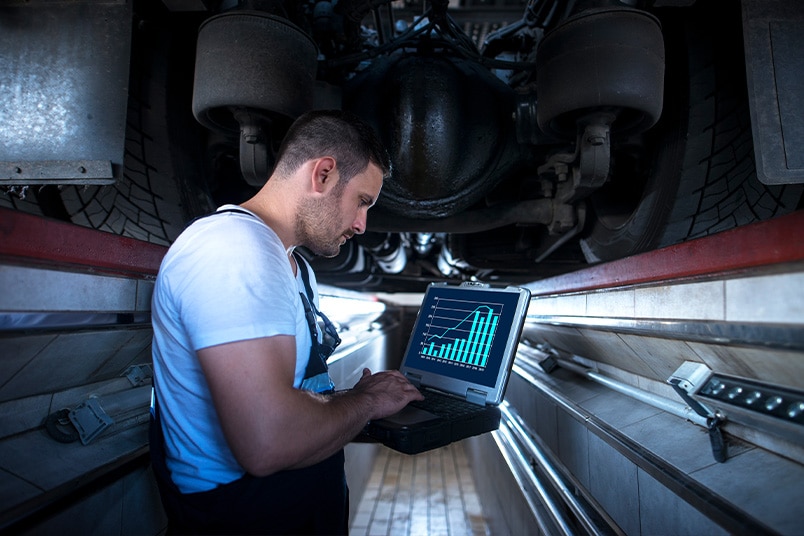Key Takeaways
- Embracing Data-Driven Decision-Making: By leveraging predictive analytics for route optimization and predictive maintenance, companies can significantly enhance efficiency and reduce operational costs.
- Adoption of Green Technologies: The shift towards eco-friendly solutions like biodiesel and electric trucks not only helps in complying with environmental regulations but also offers substantial cost savings, as evidenced by the potential fuel cost reduction over a truck’s lifespan.
- Innovative Load Planning Using Customer Data: Understanding customer patterns and preferences to optimize load planning not only improves efficiency but also maximizes revenue per trip, showcasing a customer-centric strategy in logistics.
- Focus on Driver Retention and Well-being: High turnover rates in the industry underscore the significance of driver retention through performance incentives, wellness programs, and career development opportunities.
In an era where the transportation and trucking industry faces unprecedented challenges, from fluctuating fuel prices to driver recruiting and retention, it’s clear that business owners in this sector need to shift gears and revamp their strategies to remain successful.
This article is your roadmap to the future, exploring cutting-edge strategies that can propel transportation and trucking businesses into a realm of sustained competitiveness and profitability.
We’re talking about harnessing the power of data and analytics, embracing eco-friendly technologies, engaging in collaborative logistics, implementing dynamic pricing models, and focusing on effective workforce management and driver retention.
Get ready to turbocharge your business strategy with these innovative insights!

Leveraging Big Data and Advanced Analytics
In the dynamic world of trucking and transportation, the key to staying ahead lies in embracing the power of technology and data. Route optimization through predictive analytics, predictive maintenance through machine learning, and optimizing load planning with customer data analysis are three transformative strategies that are reshaping the industry.
Let’s explore how these innovative methods set the stage for a more efficient, reliable, and customer-centric trucking industry.
Route Optimization Through Predictive Analytics
The journey to smarter route management begins with gathering comprehensive data. This includes everything from real-time traffic updates and weather conditions to roadwork information, historical route data, and valuable driver feedback. The crucial step is integrating all this data into one centralized system for effective analysis.
Next, predictive analytics tools come into play. These powerful tools sift through the vast data, identifying patterns and trends to predict potential delays and recommend the most efficient routes.
But it’s not just about planning; it’s also about adapting on the go. Systems that offer real-time route adjustments are essential. Imagine a sudden traffic jam due to an accident; the system can immediately propose an alternative route, saving precious time and fuel.
And let’s not forget the importance of a feedback loop. Drivers contribute their on-the-ground experiences, continuously enhancing the accuracy of predictive models.
Predictive Maintenance Through Machine Learning
Transforming maintenance with technology starts with outfitting trucks with sensors. These sensors monitor everything from engine performance to tire pressure, constantly sending data back for analysis.
Machine learning algorithms then take center stage, analyzing this data to spot patterns that might indicate an impending failure or maintenance need. For instance, a specific engine vibration pattern could signal a looming breakdown.
This proactive approach doesn’t just predict; it alerts. Fleet managers or drivers get notified about maintenance needs well in advance, averting costly repairs and reducing downtime. And as these algorithms learn from more data, their predictive capabilities only get sharper, streamlining maintenance schedules.
If you’d like to learn more, I recommend reading our recent blog “Harnessing the Power of Telematics: The New Frontier for Trucking.”
Optimizing Load Planning with Customer Data Analysis
Understanding customer needs is key. By analyzing historical customer order data, trends like preferred delivery times, order frequency, load sizes, and types of goods are uncovered.
This insight is then used to optimize load planning. For instance, if certain customers often order compatible goods, their shipments can be combined, maximizing efficiency.
Dynamic load planning systems take this a step further, adjusting in real time to new orders or changes, ensuring trucks are always optimally loaded, maximizing revenue per trip.
Predictive models can also forecast future customer behaviors, aiding in advanced resource allocation and meeting anticipated demand.

Adopting Green Technologies
Embracing green technologies in the transportation and trucking industry is not just an environmentally conscious move; it’s a smart business strategy for cost-saving and profit growth. With the industry’s heavy reliance on diesel fuel, the rising costs and environmental regulations are pushing a shift towards alternative, energy-efficient solutions.
Leading this eco-friendly charge are biodiesel and electric trucks. Biodiesel stands out for its ability to slash greenhouse gas emissions by up to 86%, as reported by the U.S. Department of Energy. This not only aligns with environmental mandates but also boosts the public image of transport companies, a valuable asset for marketing and customer loyalty.
Electric trucks are quickly gaining ground, with industry giants like Tesla at the helm. These vehicles are not just eco-friendly; they’re economical. The International Council on Clean Transportation (ICCT) highlights potential savings of about $200,000 in fuel costs over a truck’s lifespan. Plus, with government incentives, the initially higher costs of electric trucks are increasingly manageable.
Aerodynamics is another frontier for cost-cutting. Simple additions like side skirts and roof fairings can cut wind resistance, leading to a 5-10% reduction in fuel consumption, a significant saving given that fuel can account for up to 60% of a truck’s operational costs, according to the U.S. Environmental Protection Agency’s SmartWay program.
Solar power is also making waves, providing auxiliary power for internal systems like air conditioning and lighting. This innovation reduces fuel consumption by minimizing idle engine use. The North American Council for Freight Efficiency (NACFE) notes that solar panels can significantly power these systems, particularly in sunny regions.
The shift towards green technologies in trucking is more than an environmental gesture; it’s a financially savvy approach. With the promise of reduced fuel costs and increased operational efficiency, these technologies are paving the way for a more cost-effective and sustainable future in the transportation industry.

Workforce Management and Driver Retention
The transportation and trucking industry consistently grapples with a high turnover rate, leading to increased costs in recruitment, training, and lost productivity.
Prioritizing driver retention is not just about workforce stability; it’s a strategic move for cost efficiency. Performance-based incentives linked to safe driving, fuel efficiency, timely deliveries, and customer service have been shown to enhance driver loyalty.
Wellness programs are another vital component. Given the trucking lifestyle’s challenges, programs promoting physical health, mental well-being, and healthy living can significantly boost job satisfaction and reduce turnover.
Career advancement opportunities also play a crucial role. Drivers value growth and skill enhancement opportunities. Providing continuous training and clear career paths not only satisfies drivers but also elevates the workforce’s skill level, improving service quality and efficiency.
Leveraging technology for smarter scheduling and load assignments can further enhance driver satisfaction. Efficient route optimization and telematics for real-time management help maintain a healthy work-life balance and ensure drivers aren’t overworked, contributing to their safety and job satisfaction.
In summary, effective driver retention strategies like performance incentives, wellness programs, career development, and smart technology use can drastically cut turnover costs in trucking. These approaches lead to a more stable, skilled workforce, enhancing service quality, operational efficiency, and profitability. As the industry tackles workforce management challenges, these strategies are key to staying competitive and successful.

Conclusion
As we navigate the complex and ever-evolving landscape of the transportation and trucking industry, it’s clear that the path to success is paved with innovation and strategic adaptation.
From the pressing challenges of fluctuating fuel prices and driver retention to the relentless pursuit of cost-cutting and profit maximization, the industry stands at a pivotal crossroads. The traditional methods of yesteryear no longer suffice in this new era.
Instead, a bold, forward-thinking approach is required—one that embraces the transformative power of technology and data, and reimagines the very essence of operational efficiency and customer satisfaction.
The future of trucking is here, and the opportunity to lead the charge is yours.
FAQs About Cutting Costs and Boosting Profits in Trucking
Predictive analytics enhances route optimization by analyzing a wide range of data, including traffic patterns, weather conditions, and historical data. This leads to more efficient routes, saving time and fuel, and allows for real-time adjustments to unforeseen events.
Machine learning in truck maintenance leads to predictive maintenance strategies. By analyzing data from sensors in trucks, it can predict maintenance needs, preventing breakdowns and reducing downtime, which in turn lowers maintenance costs and improves operational efficiency.
Eco-friendly technologies, such as biodiesel and electric trucks, reduce greenhouse gas emissions and are often more cost-effective in the long run due to lower fuel costs and potential government incentives. They also improve the public image of transportation companies.
Yes, aerodynamics can greatly impact fuel efficiency. Implementations like side skirts and roof fairings reduce wind resistance, leading to a 5-10% reduction in fuel consumption, which is significant considering that fuel can account for up to 60% of a truck’s operational costs.
Driver satisfaction is crucial as it directly affects turnover rates. Strategies like performance-based incentives, wellness programs, and career advancement opportunities can enhance job satisfaction, reducing recruitment and training costs associated with high turnover.
Utilizing solar power for auxiliary systems like air conditioning and lighting can lead to significant cost savings by reducing fuel consumption. This is particularly effective in reducing idling time, which is a major contributor to unnecessary fuel usage.

